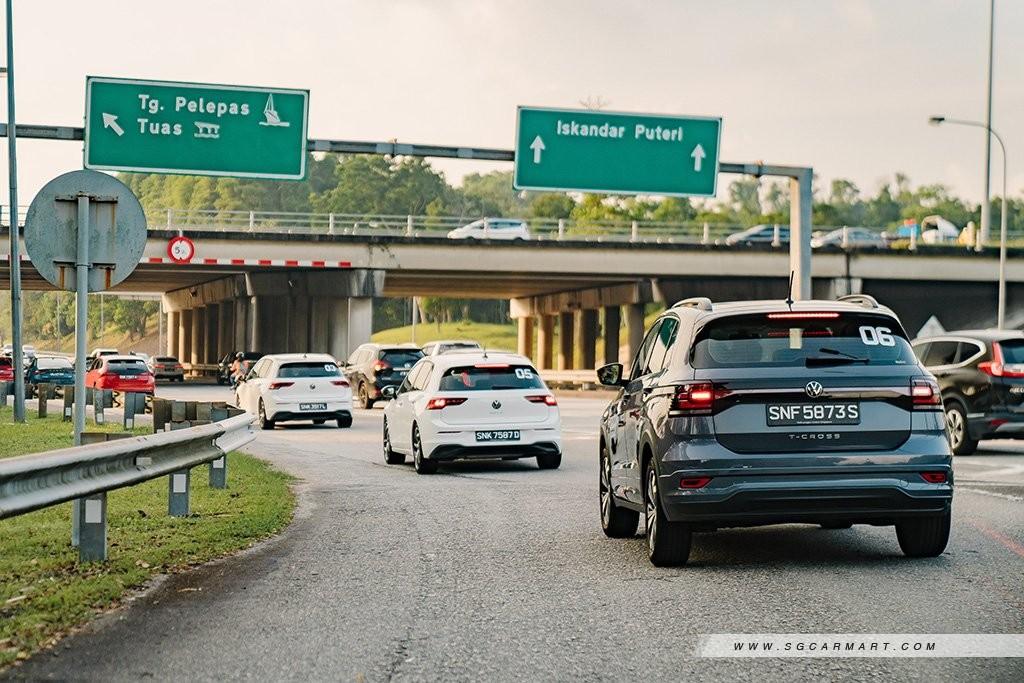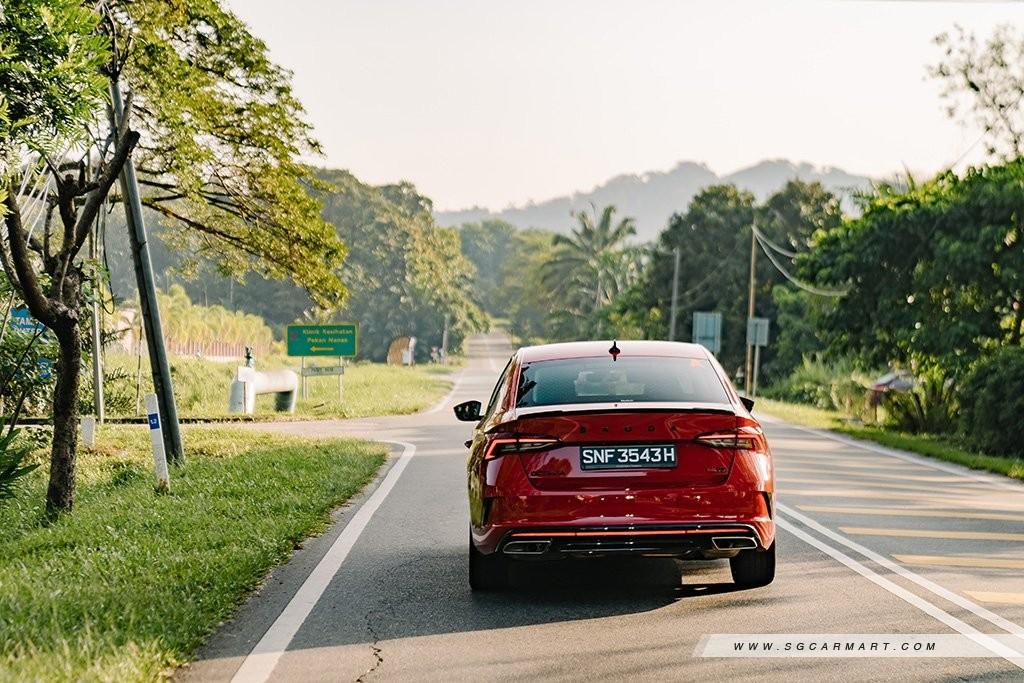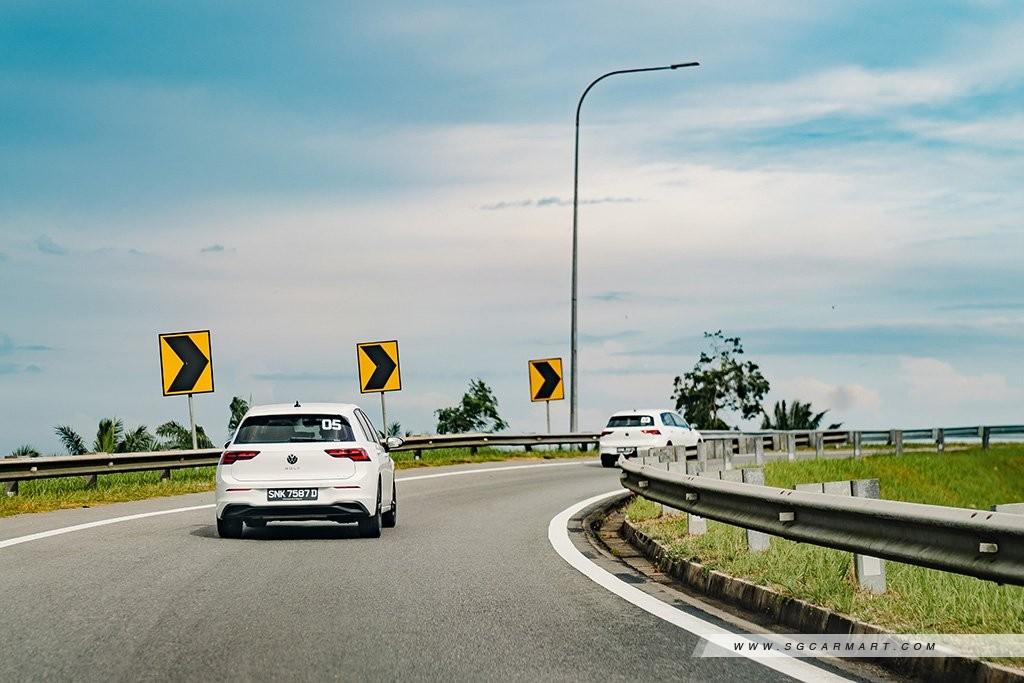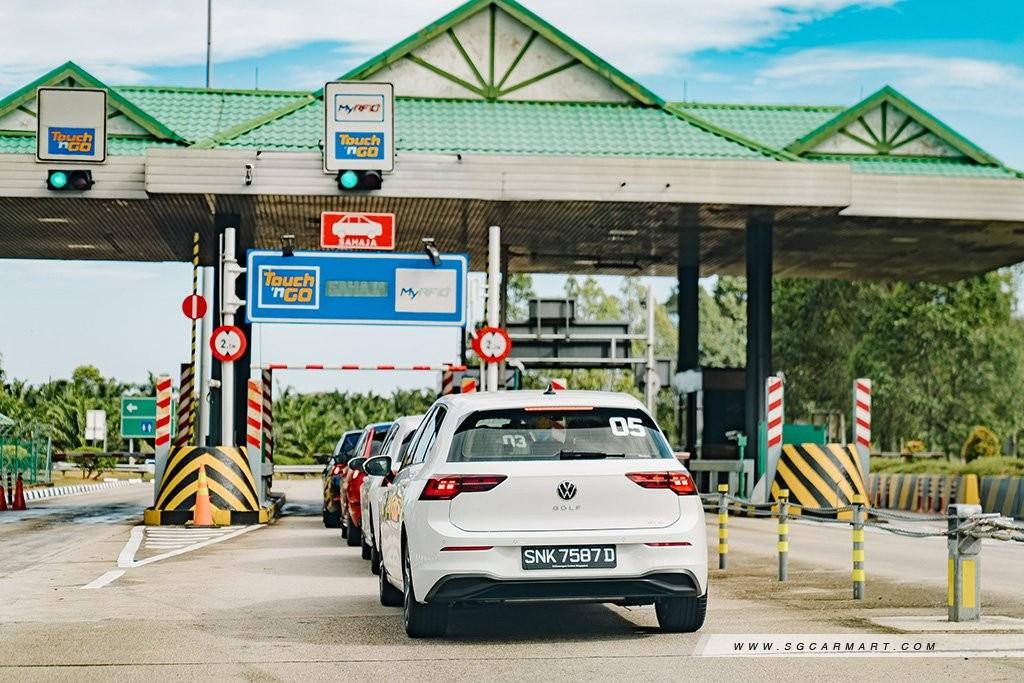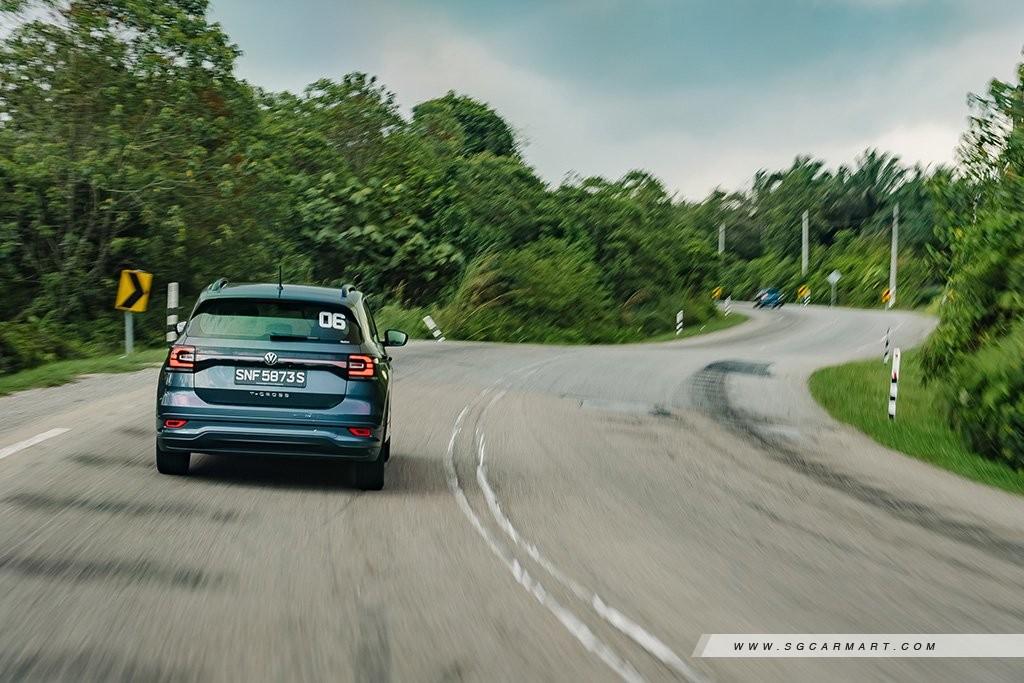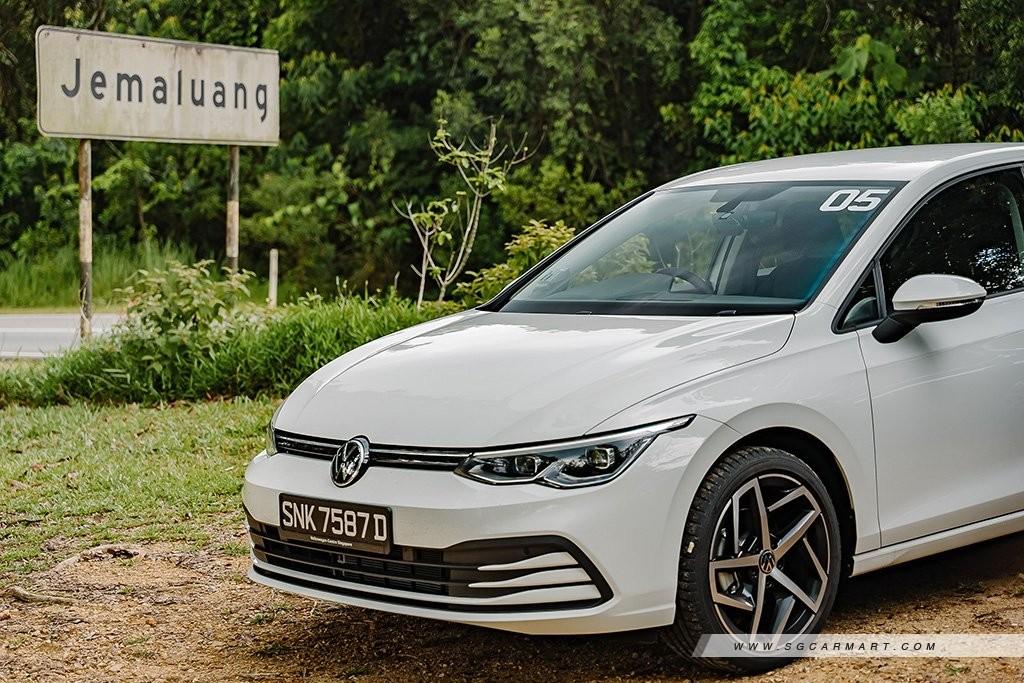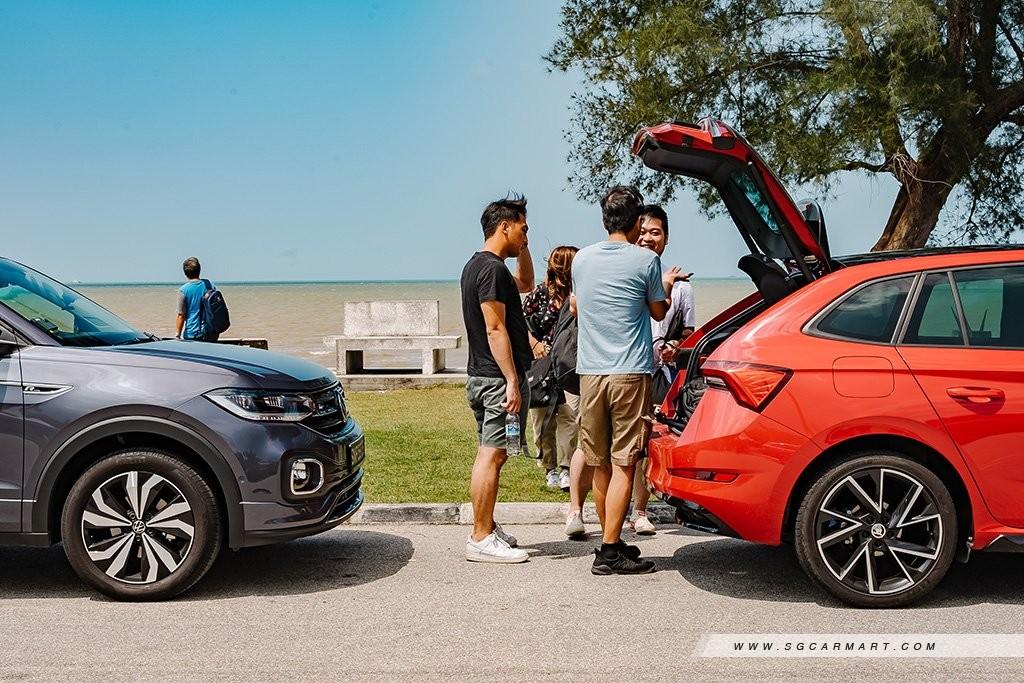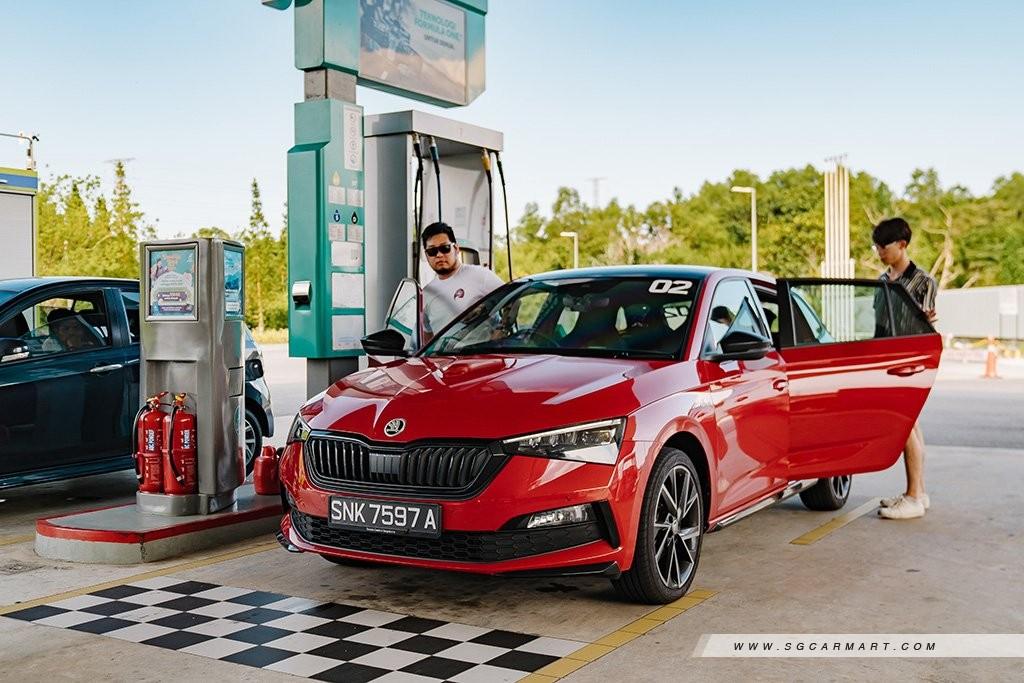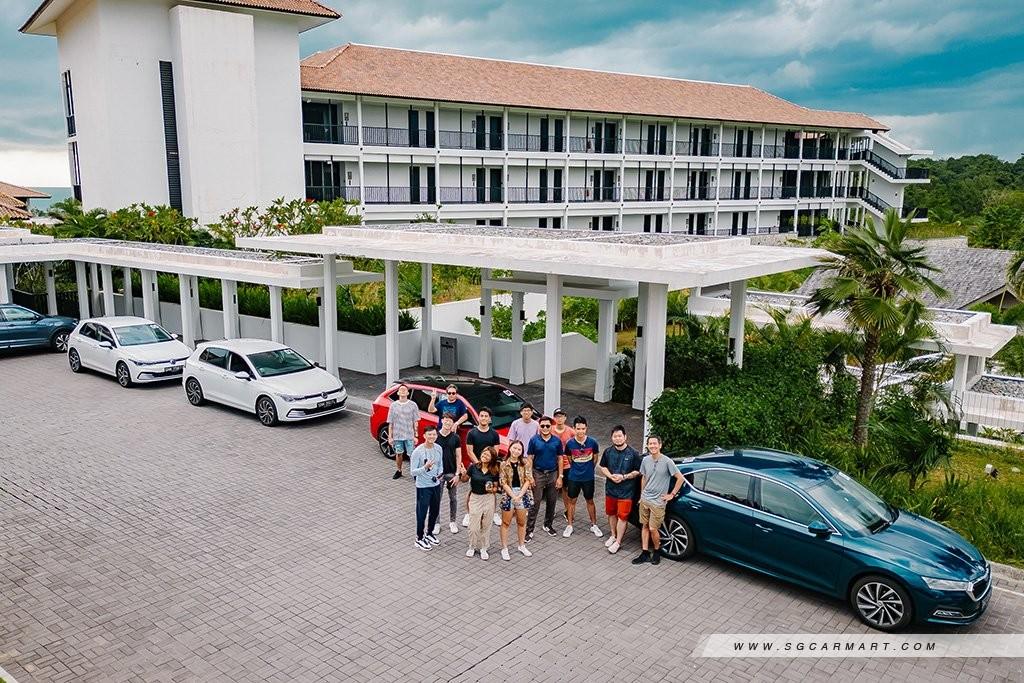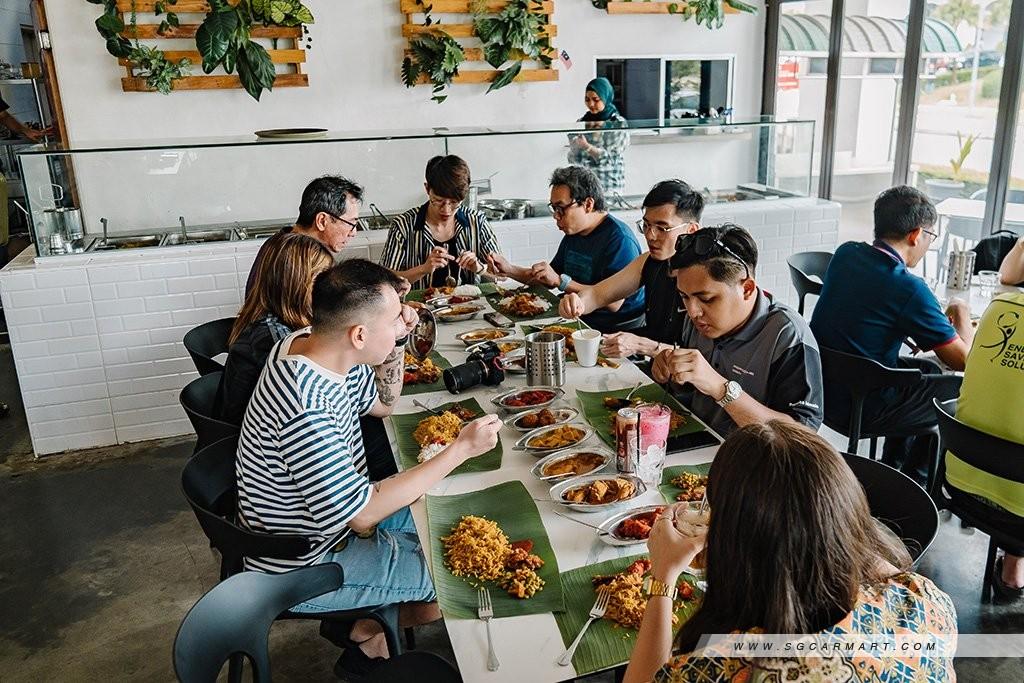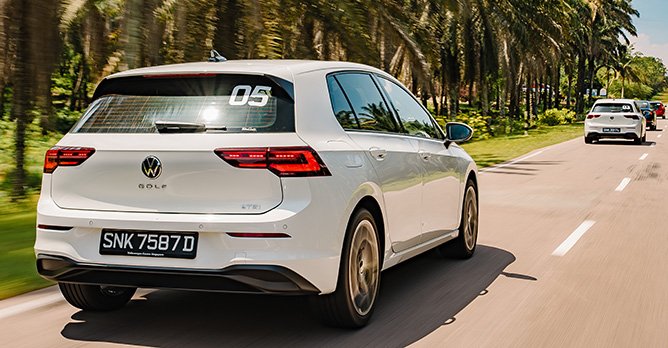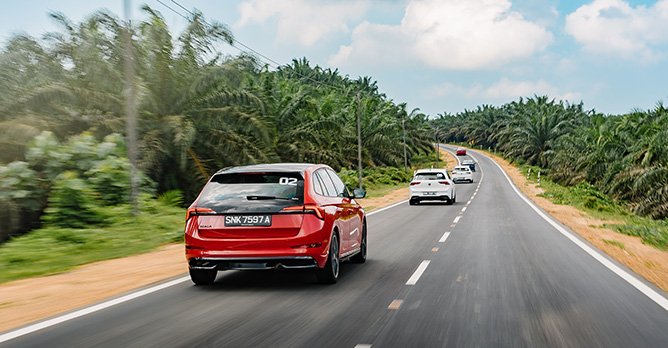The long way from Singapore to Desaru with Cat A Volkswagens and Skodas
30 May 2023|5,352 views
It's unclear exactly how the choice for the lead car was made - especially when a less hardcore Volkswagen Tiguan is clearly also available, sweeping the rear.
But the fact that Volkswagen and Skoda Singapore have designated a Skoda Octavia RS the alpha vehicle for our convoy says a lot about the faith it has in the cars we're driving behind.
To be clear, these are categorically not - and not supposed to be - on the level of the Octavia RS. That Velvet Red sedan burning up the tarmac in front has its own secret weapons, including Dynamic Chassis Control, stronger brakes and the tried-and-tested dynamite stick that is the EA888 engine. As we cut horizontally across Southern Malaysia, however, the pack is just about holding its own - and with surprising finesse too.
Four models, three body styles, two different engines, one common purpose

 From left to right: The Octavia, Scala, and Golf have joined the T-Cross (right at the end) in Cat A We are on a drive from Singapore to Desaru with a special crew of Volkswagens and Skodas. And on both German and Czech territory, a more mature sibling accompanies a significantly newer entrant thus far still in its first generation.
From left to right: The Octavia, Scala, and Golf have joined the T-Cross (right at the end) in Cat A We are on a drive from Singapore to Desaru with a special crew of Volkswagens and Skodas. And on both German and Czech territory, a more mature sibling accompanies a significantly newer entrant thus far still in its first generation.
Alongside the Skoda Octavia stands the Skoda Scala, a compact hatch meant to slot in above the Fabia (no longer sold in Singapore). The relatively fresh Volkswagen T-Cross, on the other hand, is towered over - not physically, of course - by one of Wolfsburg's outright icons: The Mk8 Golf.
None of the members of this quartet would be classified normally as a luxury car… except if one lived in Singapore.
As they landed one after another on our shores in 2021, however, the Scala, Octavia and Golf all found themselves shoved into Category B. The reason? The same heart: A turbocharged 1.5-litre inline-four engine pushing out 148bhp and 250Nm of torque. (The T-Cross has thankfully eluded that fate since it was offered from Day 1 with a 1.0-litre engine producing 114bhp and 200Nm.)
Things have changed since. The Octavia and Scala now also utilise a 1.0-litre three-pot, producing 109bhp, while the Golf's engine has simply been tuned to 129bhp. Less power is rarely welcome, but the promise of extra affordability is hard to ignore. With these moves, the diverse group has finally been reunited in Category A.
Taking the long way: Breakfast first at Yong Peng

 The Mk8 Golf is arguably even more alluring now that it promises to be slightly more affordable in this price climate When plotted out on Google Maps, Singapore to Desaru looks straightforward - a drive dominated by the Senai-Desaru Expressway that won't exceed three hours even if one chooses to veer westward via the Second Link. If you depart Singapore at 7:30am, lunch by the sea at 12:30pm shouldn't be unrealistic. Correct?
The Mk8 Golf is arguably even more alluring now that it promises to be slightly more affordable in this price climate When plotted out on Google Maps, Singapore to Desaru looks straightforward - a drive dominated by the Senai-Desaru Expressway that won't exceed three hours even if one chooses to veer westward via the Second Link. If you depart Singapore at 7:30am, lunch by the sea at 12:30pm shouldn't be unrealistic. Correct?
Not quite. Instead of darting straight for the eastern coast, we move in the opposite direction, before shooting up into Yong Peng for breakfast at Sunroast Restaurant. It's all part of an elaborate plan to stretch the legs of our motley crew of cars.
Admittedly, this initial portion isn't where the roads have started to fold into themselves. Save for the final stretch, we only get a brief experience around some mildly twisty roads in our first car, the 129bhp Golf Life.
On the highway, however, the hatch still accelerates with good verve, and willingly hangs onto three digits when prodding the speed limit here. It may have traded the multi-link rear suspension of earlier variants for a torsion beam one, too, but ride quality remains very decent.
Even better, the Golf's unaltered mild hybrid system make start-stops through some initially denser traffic more bearable. When coasting, ever so often, the needle plummets all the way to zero on its 10.25-inch driver's display as the car shuts its engine off.
We are not attempting a fuel efficiency challenge, but the Golf is also a family-friendly car at its core. Any reminder, at any time, of the versatility wielded by a household name is never unwelcome.
Cutting across Southern Malaysia

 B-road bombing: Probably not what the T-Cross was born to do. Still, it manages better than one might expect Phase 2 of our journey is where the real fun starts: A 200km drive that should lead us to the eastern shoreline through Paloh, Kluang, then Jemaluang. It's also when we clamber into the chipper Volkswagen T-Cross.
B-road bombing: Probably not what the T-Cross was born to do. Still, it manages better than one might expect Phase 2 of our journey is where the real fun starts: A 200km drive that should lead us to the eastern shoreline through Paloh, Kluang, then Jemaluang. It's also when we clamber into the chipper Volkswagen T-Cross.
Route 50, which takes up nearly half of this stretch, is quite possibly The Enthusiast Dream brought to life; an endless orange-tinged grey carpet of winding crests and dips unrolled at the feet (wheels) of the cars.
B-road bombing is expressly not what the T-Cross was designed for, and there are limits to how far I, with my admittedly limited experience, am willing to push a front-wheel driven crossover through snaking two-way roads. Even with my more seasoned experienced co-driver at the helm, the laws of physics cannot be bent. We inevitably find ourselves falling behind.
Still, the T-Cross feels tighter than one might imagine given its raised height, and is capable enough of getting just a slight flogging, aided in part by its reassuring brakes and grip. Past signboards warning us to look out for monkeys and cows, it is still willed into brisk pace.
The final vehicle swap of the day occurs at Jason Bay Beach. For a car sharing underpinnings with the T-Cross, there are already a couple of immediately noticeable differences as we load the Skoda Scala up. Number one: Its 467-litre boot, larger than even the Golf's, and the generous space in the rear.
In Monte Carlo trim, the Scala also cuts the most striking figure with its racy red paintwork and black grille. Just as the increase in ride height is unmistakable when going into the T-Cross, so too is the lowered seating position welcome as we get into its driver's seat.
Initially, it feels like a shame; the meandering two-way roads have stiffened out again, punctuated by bends far gentler than what we've just experienced. But as we blaze forth in the direction of lunch, the Scala is still deeply delightful to pilot.
While a 1.0-litre three-pot under the hood means burying one's right foot into the pedal will not result in head-pinned-back force, the Scala impresses instead with its sense of sturdiness, willingness to keep gathering speed, and (less abstractly) its superbly supportive sports seats.
As we climb out and head towards the scrumptious spread and sweet air-conditioning waiting at Jade Garden Seafood Restaurant - perched picturesquely next to the sea - I find myself looking back at it with more admiration than at Jason Bay Beach.
The Czech dark horse

 The Golf Life (pictured) has different alloys, and a slightly shorter spec list than the Life Plus behind it Both logic and legend dictate that the Golf should be the most well-loved of the bunch. To a large extent, this is true.
The Golf Life (pictured) has different alloys, and a slightly shorter spec list than the Life Plus behind it Both logic and legend dictate that the Golf should be the most well-loved of the bunch. To a large extent, this is true.
Over the one and a half days, there is no shortage of fanfare over both variants of the hatch - the Life and Life Plus, the latter of which we get into first on the second day. Extra niceties over the Life trim include tri-zone air-conditioning, and snazzier touches on the exterior, including taillights with different elements and dynamic turn indicators.
But it is perhaps the final car that we get into for the trip that leaves the deepest impression. The Octavia is built on the same MQB Evo platform as the Golf, but in typical Skoda-fashion, takes things half a size up.
Its wheelbase is the longest here, at 2,686mm, which translates into excellent passenger space. Its boot? Cavernous, at 600 litres. Life Plus; Monte Carlo; R-Line - the cars on the trip are in top-of-the-line trim levels, but even among these heavier-hitters, the Octavia in Style trim boasts the fattest equipment list.
With three key goals on our itinerary today - a few (wet) laps at RUD Karting Medini, The Banana Leaf Kitchen, then crossing back into Singapore before peak hour hits - it is no longer the long but quick way that we take back.
On the Senari-Desaru Expressway, the mild hybrid Octavia, even with its 1.0-litre engine, keeps up with surprising ease. It is stable and poised, and even feels the most 'grown up' of the bunch with its comfortable ride and deftness in keeping out wind and road noise (considering the speeds we're doing). Back across the Second Link, when traffic is thrown back into slow motion once more, the Octavia feels even less lethargic.
Who says Category A cars cannot also offer some fun?
With ostensibly less power, there is no disguising that some patience is required to get each of these five cars up to speed.
Just because they're not firecrackers, however, does not render them unworthy of respect. Power can be taken out of a car to make it less powerful and thus tax-friendly - but that does not change the breadth of capabilities intentionally engineered into it. If you need a reminder, look no further than at the three support cars sharing similar base templates to the Golf and Octavia: The Golf GTI, Octavia RS and Octavia Combi RS.
Over the last one-and-a-half days, the five machines we've driven have proven their mettle as steady steeds for the occasional road trip out of Singapore. Even as currently trying times almost necessitate a Category A COE, these are still tough companions that will not resist the suggestion of some fun.
Let's not forget, too: The casual buyer of any of these cars is unlikely to find themselves trying to keep pace with an Octavia RS on an extended drive through Southwestern Malaysia. Should their Google Maps 'accidentally' malfunction, however... and should they find themselves wandering out onto a B-road... they won't be left hanging.
Here are a few other recent road trip stories that may interest you!
Forget the NS Highway, East Coast Malaysia is where driving fun lies
From SG to Thailand in less than a tank with Audi's Q3 Sportback: Here's how
Downsizing doesn't mean downgrading: Three days and 1,800km of driving in Audi's Q3 Sportback 1.5 and A3 Sedan 1.0
What a haphazardly planned road trip to KL with three colleagues taught me
But the fact that Volkswagen and Skoda Singapore have designated a Skoda Octavia RS the alpha vehicle for our convoy says a lot about the faith it has in the cars we're driving behind.
To be clear, these are categorically not - and not supposed to be - on the level of the Octavia RS. That Velvet Red sedan burning up the tarmac in front has its own secret weapons, including Dynamic Chassis Control, stronger brakes and the tried-and-tested dynamite stick that is the EA888 engine. As we cut horizontally across Southern Malaysia, however, the pack is just about holding its own - and with surprising finesse too.
Four models, three body styles, two different engines, one common purpose

Alongside the Skoda Octavia stands the Skoda Scala, a compact hatch meant to slot in above the Fabia (no longer sold in Singapore). The relatively fresh Volkswagen T-Cross, on the other hand, is towered over - not physically, of course - by one of Wolfsburg's outright icons: The Mk8 Golf.
None of the members of this quartet would be classified normally as a luxury car… except if one lived in Singapore.
As they landed one after another on our shores in 2021, however, the Scala, Octavia and Golf all found themselves shoved into Category B. The reason? The same heart: A turbocharged 1.5-litre inline-four engine pushing out 148bhp and 250Nm of torque. (The T-Cross has thankfully eluded that fate since it was offered from Day 1 with a 1.0-litre engine producing 114bhp and 200Nm.)
Things have changed since. The Octavia and Scala now also utilise a 1.0-litre three-pot, producing 109bhp, while the Golf's engine has simply been tuned to 129bhp. Less power is rarely welcome, but the promise of extra affordability is hard to ignore. With these moves, the diverse group has finally been reunited in Category A.
Taking the long way: Breakfast first at Yong Peng

Not quite. Instead of darting straight for the eastern coast, we move in the opposite direction, before shooting up into Yong Peng for breakfast at Sunroast Restaurant. It's all part of an elaborate plan to stretch the legs of our motley crew of cars.
Admittedly, this initial portion isn't where the roads have started to fold into themselves. Save for the final stretch, we only get a brief experience around some mildly twisty roads in our first car, the 129bhp Golf Life.
On the highway, however, the hatch still accelerates with good verve, and willingly hangs onto three digits when prodding the speed limit here. It may have traded the multi-link rear suspension of earlier variants for a torsion beam one, too, but ride quality remains very decent.
Even better, the Golf's unaltered mild hybrid system make start-stops through some initially denser traffic more bearable. When coasting, ever so often, the needle plummets all the way to zero on its 10.25-inch driver's display as the car shuts its engine off.
We are not attempting a fuel efficiency challenge, but the Golf is also a family-friendly car at its core. Any reminder, at any time, of the versatility wielded by a household name is never unwelcome.
Cutting across Southern Malaysia

Route 50, which takes up nearly half of this stretch, is quite possibly The Enthusiast Dream brought to life; an endless orange-tinged grey carpet of winding crests and dips unrolled at the feet (wheels) of the cars.
B-road bombing is expressly not what the T-Cross was designed for, and there are limits to how far I, with my admittedly limited experience, am willing to push a front-wheel driven crossover through snaking two-way roads. Even with my more seasoned experienced co-driver at the helm, the laws of physics cannot be bent. We inevitably find ourselves falling behind.
Still, the T-Cross feels tighter than one might imagine given its raised height, and is capable enough of getting just a slight flogging, aided in part by its reassuring brakes and grip. Past signboards warning us to look out for monkeys and cows, it is still willed into brisk pace.
The final vehicle swap of the day occurs at Jason Bay Beach. For a car sharing underpinnings with the T-Cross, there are already a couple of immediately noticeable differences as we load the Skoda Scala up. Number one: Its 467-litre boot, larger than even the Golf's, and the generous space in the rear.
In Monte Carlo trim, the Scala also cuts the most striking figure with its racy red paintwork and black grille. Just as the increase in ride height is unmistakable when going into the T-Cross, so too is the lowered seating position welcome as we get into its driver's seat.
Initially, it feels like a shame; the meandering two-way roads have stiffened out again, punctuated by bends far gentler than what we've just experienced. But as we blaze forth in the direction of lunch, the Scala is still deeply delightful to pilot.
While a 1.0-litre three-pot under the hood means burying one's right foot into the pedal will not result in head-pinned-back force, the Scala impresses instead with its sense of sturdiness, willingness to keep gathering speed, and (less abstractly) its superbly supportive sports seats.
As we climb out and head towards the scrumptious spread and sweet air-conditioning waiting at Jade Garden Seafood Restaurant - perched picturesquely next to the sea - I find myself looking back at it with more admiration than at Jason Bay Beach.
The Czech dark horse

Over the one and a half days, there is no shortage of fanfare over both variants of the hatch - the Life and Life Plus, the latter of which we get into first on the second day. Extra niceties over the Life trim include tri-zone air-conditioning, and snazzier touches on the exterior, including taillights with different elements and dynamic turn indicators.
But it is perhaps the final car that we get into for the trip that leaves the deepest impression. The Octavia is built on the same MQB Evo platform as the Golf, but in typical Skoda-fashion, takes things half a size up.
Its wheelbase is the longest here, at 2,686mm, which translates into excellent passenger space. Its boot? Cavernous, at 600 litres. Life Plus; Monte Carlo; R-Line - the cars on the trip are in top-of-the-line trim levels, but even among these heavier-hitters, the Octavia in Style trim boasts the fattest equipment list.
With three key goals on our itinerary today - a few (wet) laps at RUD Karting Medini, The Banana Leaf Kitchen, then crossing back into Singapore before peak hour hits - it is no longer the long but quick way that we take back.
On the Senari-Desaru Expressway, the mild hybrid Octavia, even with its 1.0-litre engine, keeps up with surprising ease. It is stable and poised, and even feels the most 'grown up' of the bunch with its comfortable ride and deftness in keeping out wind and road noise (considering the speeds we're doing). Back across the Second Link, when traffic is thrown back into slow motion once more, the Octavia feels even less lethargic.
Who says Category A cars cannot also offer some fun?
With ostensibly less power, there is no disguising that some patience is required to get each of these five cars up to speed.
Just because they're not firecrackers, however, does not render them unworthy of respect. Power can be taken out of a car to make it less powerful and thus tax-friendly - but that does not change the breadth of capabilities intentionally engineered into it. If you need a reminder, look no further than at the three support cars sharing similar base templates to the Golf and Octavia: The Golf GTI, Octavia RS and Octavia Combi RS.
Over the last one-and-a-half days, the five machines we've driven have proven their mettle as steady steeds for the occasional road trip out of Singapore. Even as currently trying times almost necessitate a Category A COE, these are still tough companions that will not resist the suggestion of some fun.
Let's not forget, too: The casual buyer of any of these cars is unlikely to find themselves trying to keep pace with an Octavia RS on an extended drive through Southwestern Malaysia. Should their Google Maps 'accidentally' malfunction, however... and should they find themselves wandering out onto a B-road... they won't be left hanging.
Here are a few other recent road trip stories that may interest you!
Forget the NS Highway, East Coast Malaysia is where driving fun lies
From SG to Thailand in less than a tank with Audi's Q3 Sportback: Here's how
Downsizing doesn't mean downgrading: Three days and 1,800km of driving in Audi's Q3 Sportback 1.5 and A3 Sedan 1.0
What a haphazardly planned road trip to KL with three colleagues taught me
It's unclear exactly how the choice for the lead car was made - especially when a less hardcore Volkswagen Tiguan is clearly also available, sweeping the rear.
But the fact that Volkswagen and Skoda Singapore have designated a Skoda Octavia RS the alpha vehicle for our convoy says a lot about the faith it has in the cars we're driving behind.
To be clear, these are categorically not - and not supposed to be - on the level of the Octavia RS. That Velvet Red sedan burning up the tarmac in front has its own secret weapons, including Dynamic Chassis Control, stronger brakes and the tried-and-tested dynamite stick that is the EA888 engine. As we cut horizontally across Southern Malaysia, however, the pack is just about holding its own - and with surprising finesse too.
Four models, three body styles, two different engines, one common purpose

 From left to right: The Octavia, Scala, and Golf have joined the T-Cross (right at the end) in Cat A We are on a drive from Singapore to Desaru with a special crew of Volkswagens and Skodas. And on both German and Czech territory, a more mature sibling accompanies a significantly newer entrant thus far still in its first generation.
From left to right: The Octavia, Scala, and Golf have joined the T-Cross (right at the end) in Cat A We are on a drive from Singapore to Desaru with a special crew of Volkswagens and Skodas. And on both German and Czech territory, a more mature sibling accompanies a significantly newer entrant thus far still in its first generation.
Alongside the Skoda Octavia stands the Skoda Scala, a compact hatch meant to slot in above the Fabia (no longer sold in Singapore). The relatively fresh Volkswagen T-Cross, on the other hand, is towered over - not physically, of course - by one of Wolfsburg's outright icons: The Mk8 Golf.
None of the members of this quartet would be classified normally as a luxury car… except if one lived in Singapore.
As they landed one after another on our shores in 2021, however, the Scala, Octavia and Golf all found themselves shoved into Category B. The reason? The same heart: A turbocharged 1.5-litre inline-four engine pushing out 148bhp and 250Nm of torque. (The T-Cross has thankfully eluded that fate since it was offered from Day 1 with a 1.0-litre engine producing 114bhp and 200Nm.)
Things have changed since. The Octavia and Scala now also utilise a 1.0-litre three-pot, producing 109bhp, while the Golf's engine has simply been tuned to 129bhp. Less power is rarely welcome, but the promise of extra affordability is hard to ignore. With these moves, the diverse group has finally been reunited in Category A.
Taking the long way: Breakfast first at Yong Peng

 The Mk8 Golf is arguably even more alluring now that it promises to be slightly more affordable in this price climate When plotted out on Google Maps, Singapore to Desaru looks straightforward - a drive dominated by the Senai-Desaru Expressway that won't exceed three hours even if one chooses to veer westward via the Second Link. If you depart Singapore at 7:30am, lunch by the sea at 12:30pm shouldn't be unrealistic. Correct?
The Mk8 Golf is arguably even more alluring now that it promises to be slightly more affordable in this price climate When plotted out on Google Maps, Singapore to Desaru looks straightforward - a drive dominated by the Senai-Desaru Expressway that won't exceed three hours even if one chooses to veer westward via the Second Link. If you depart Singapore at 7:30am, lunch by the sea at 12:30pm shouldn't be unrealistic. Correct?
Not quite. Instead of darting straight for the eastern coast, we move in the opposite direction, before shooting up into Yong Peng for breakfast at Sunroast Restaurant. It's all part of an elaborate plan to stretch the legs of our motley crew of cars.
Admittedly, this initial portion isn't where the roads have started to fold into themselves. Save for the final stretch, we only get a brief experience around some mildly twisty roads in our first car, the 129bhp Golf Life.
On the highway, however, the hatch still accelerates with good verve, and willingly hangs onto three digits when prodding the speed limit here. It may have traded the multi-link rear suspension of earlier variants for a torsion beam one, too, but ride quality remains very decent.
Even better, the Golf's unaltered mild hybrid system make start-stops through some initially denser traffic more bearable. When coasting, ever so often, the needle plummets all the way to zero on its 10.25-inch driver's display as the car shuts its engine off.
We are not attempting a fuel efficiency challenge, but the Golf is also a family-friendly car at its core. Any reminder, at any time, of the versatility wielded by a household name is never unwelcome.
Cutting across Southern Malaysia

 B-road bombing: Probably not what the T-Cross was born to do. Still, it manages better than one might expect Phase 2 of our journey is where the real fun starts: A 200km drive that should lead us to the eastern shoreline through Paloh, Kluang, then Jemaluang. It's also when we clamber into the chipper Volkswagen T-Cross.
B-road bombing: Probably not what the T-Cross was born to do. Still, it manages better than one might expect Phase 2 of our journey is where the real fun starts: A 200km drive that should lead us to the eastern shoreline through Paloh, Kluang, then Jemaluang. It's also when we clamber into the chipper Volkswagen T-Cross.
Route 50, which takes up nearly half of this stretch, is quite possibly The Enthusiast Dream brought to life; an endless orange-tinged grey carpet of winding crests and dips unrolled at the feet (wheels) of the cars.
B-road bombing is expressly not what the T-Cross was designed for, and there are limits to how far I, with my admittedly limited experience, am willing to push a front-wheel driven crossover through snaking two-way roads. Even with my more seasoned experienced co-driver at the helm, the laws of physics cannot be bent. We inevitably find ourselves falling behind.
Still, the T-Cross feels tighter than one might imagine given its raised height, and is capable enough of getting just a slight flogging, aided in part by its reassuring brakes and grip. Past signboards warning us to look out for monkeys and cows, it is still willed into brisk pace.
The final vehicle swap of the day occurs at Jason Bay Beach. For a car sharing underpinnings with the T-Cross, there are already a couple of immediately noticeable differences as we load the Skoda Scala up. Number one: Its 467-litre boot, larger than even the Golf's, and the generous space in the rear.
In Monte Carlo trim, the Scala also cuts the most striking figure with its racy red paintwork and black grille. Just as the increase in ride height is unmistakable when going into the T-Cross, so too is the lowered seating position welcome as we get into its driver's seat.
Initially, it feels like a shame; the meandering two-way roads have stiffened out again, punctuated by bends far gentler than what we've just experienced. But as we blaze forth in the direction of lunch, the Scala is still deeply delightful to pilot.
While a 1.0-litre three-pot under the hood means burying one's right foot into the pedal will not result in head-pinned-back force, the Scala impresses instead with its sense of sturdiness, willingness to keep gathering speed, and (less abstractly) its superbly supportive sports seats.
As we climb out and head towards the scrumptious spread and sweet air-conditioning waiting at Jade Garden Seafood Restaurant - perched picturesquely next to the sea - I find myself looking back at it with more admiration than at Jason Bay Beach.
The Czech dark horse

 The Golf Life (pictured) has different alloys, and a slightly shorter spec list than the Life Plus behind it Both logic and legend dictate that the Golf should be the most well-loved of the bunch. To a large extent, this is true.
The Golf Life (pictured) has different alloys, and a slightly shorter spec list than the Life Plus behind it Both logic and legend dictate that the Golf should be the most well-loved of the bunch. To a large extent, this is true.
Over the one and a half days, there is no shortage of fanfare over both variants of the hatch - the Life and Life Plus, the latter of which we get into first on the second day. Extra niceties over the Life trim include tri-zone air-conditioning, and snazzier touches on the exterior, including taillights with different elements and dynamic turn indicators.
But it is perhaps the final car that we get into for the trip that leaves the deepest impression. The Octavia is built on the same MQB Evo platform as the Golf, but in typical Skoda-fashion, takes things half a size up.
Its wheelbase is the longest here, at 2,686mm, which translates into excellent passenger space. Its boot? Cavernous, at 600 litres. Life Plus; Monte Carlo; R-Line - the cars on the trip are in top-of-the-line trim levels, but even among these heavier-hitters, the Octavia in Style trim boasts the fattest equipment list.
With three key goals on our itinerary today - a few (wet) laps at RUD Karting Medini, The Banana Leaf Kitchen, then crossing back into Singapore before peak hour hits - it is no longer the long but quick way that we take back.
On the Senari-Desaru Expressway, the mild hybrid Octavia, even with its 1.0-litre engine, keeps up with surprising ease. It is stable and poised, and even feels the most 'grown up' of the bunch with its comfortable ride and deftness in keeping out wind and road noise (considering the speeds we're doing). Back across the Second Link, when traffic is thrown back into slow motion once more, the Octavia feels even less lethargic.
Who says Category A cars cannot also offer some fun?
With ostensibly less power, there is no disguising that some patience is required to get each of these five cars up to speed.
Just because they're not firecrackers, however, does not render them unworthy of respect. Power can be taken out of a car to make it less powerful and thus tax-friendly - but that does not change the breadth of capabilities intentionally engineered into it. If you need a reminder, look no further than at the three support cars sharing similar base templates to the Golf and Octavia: The Golf GTI, Octavia RS and Octavia Combi RS.
Over the last one-and-a-half days, the five machines we've driven have proven their mettle as steady steeds for the occasional road trip out of Singapore. Even as currently trying times almost necessitate a Category A COE, these are still tough companions that will not resist the suggestion of some fun.
Let's not forget, too: The casual buyer of any of these cars is unlikely to find themselves trying to keep pace with an Octavia RS on an extended drive through Southwestern Malaysia. Should their Google Maps 'accidentally' malfunction, however... and should they find themselves wandering out onto a B-road... they won't be left hanging.
Here are a few other recent road trip stories that may interest you!
Forget the NS Highway, East Coast Malaysia is where driving fun lies
From SG to Thailand in less than a tank with Audi's Q3 Sportback: Here's how
Downsizing doesn't mean downgrading: Three days and 1,800km of driving in Audi's Q3 Sportback 1.5 and A3 Sedan 1.0
What a haphazardly planned road trip to KL with three colleagues taught me
But the fact that Volkswagen and Skoda Singapore have designated a Skoda Octavia RS the alpha vehicle for our convoy says a lot about the faith it has in the cars we're driving behind.
To be clear, these are categorically not - and not supposed to be - on the level of the Octavia RS. That Velvet Red sedan burning up the tarmac in front has its own secret weapons, including Dynamic Chassis Control, stronger brakes and the tried-and-tested dynamite stick that is the EA888 engine. As we cut horizontally across Southern Malaysia, however, the pack is just about holding its own - and with surprising finesse too.
Four models, three body styles, two different engines, one common purpose

Alongside the Skoda Octavia stands the Skoda Scala, a compact hatch meant to slot in above the Fabia (no longer sold in Singapore). The relatively fresh Volkswagen T-Cross, on the other hand, is towered over - not physically, of course - by one of Wolfsburg's outright icons: The Mk8 Golf.
None of the members of this quartet would be classified normally as a luxury car… except if one lived in Singapore.
As they landed one after another on our shores in 2021, however, the Scala, Octavia and Golf all found themselves shoved into Category B. The reason? The same heart: A turbocharged 1.5-litre inline-four engine pushing out 148bhp and 250Nm of torque. (The T-Cross has thankfully eluded that fate since it was offered from Day 1 with a 1.0-litre engine producing 114bhp and 200Nm.)
Things have changed since. The Octavia and Scala now also utilise a 1.0-litre three-pot, producing 109bhp, while the Golf's engine has simply been tuned to 129bhp. Less power is rarely welcome, but the promise of extra affordability is hard to ignore. With these moves, the diverse group has finally been reunited in Category A.
Taking the long way: Breakfast first at Yong Peng

Not quite. Instead of darting straight for the eastern coast, we move in the opposite direction, before shooting up into Yong Peng for breakfast at Sunroast Restaurant. It's all part of an elaborate plan to stretch the legs of our motley crew of cars.
Admittedly, this initial portion isn't where the roads have started to fold into themselves. Save for the final stretch, we only get a brief experience around some mildly twisty roads in our first car, the 129bhp Golf Life.
On the highway, however, the hatch still accelerates with good verve, and willingly hangs onto three digits when prodding the speed limit here. It may have traded the multi-link rear suspension of earlier variants for a torsion beam one, too, but ride quality remains very decent.
Even better, the Golf's unaltered mild hybrid system make start-stops through some initially denser traffic more bearable. When coasting, ever so often, the needle plummets all the way to zero on its 10.25-inch driver's display as the car shuts its engine off.
We are not attempting a fuel efficiency challenge, but the Golf is also a family-friendly car at its core. Any reminder, at any time, of the versatility wielded by a household name is never unwelcome.
Cutting across Southern Malaysia

Route 50, which takes up nearly half of this stretch, is quite possibly The Enthusiast Dream brought to life; an endless orange-tinged grey carpet of winding crests and dips unrolled at the feet (wheels) of the cars.
B-road bombing is expressly not what the T-Cross was designed for, and there are limits to how far I, with my admittedly limited experience, am willing to push a front-wheel driven crossover through snaking two-way roads. Even with my more seasoned experienced co-driver at the helm, the laws of physics cannot be bent. We inevitably find ourselves falling behind.
Still, the T-Cross feels tighter than one might imagine given its raised height, and is capable enough of getting just a slight flogging, aided in part by its reassuring brakes and grip. Past signboards warning us to look out for monkeys and cows, it is still willed into brisk pace.
The final vehicle swap of the day occurs at Jason Bay Beach. For a car sharing underpinnings with the T-Cross, there are already a couple of immediately noticeable differences as we load the Skoda Scala up. Number one: Its 467-litre boot, larger than even the Golf's, and the generous space in the rear.
In Monte Carlo trim, the Scala also cuts the most striking figure with its racy red paintwork and black grille. Just as the increase in ride height is unmistakable when going into the T-Cross, so too is the lowered seating position welcome as we get into its driver's seat.
Initially, it feels like a shame; the meandering two-way roads have stiffened out again, punctuated by bends far gentler than what we've just experienced. But as we blaze forth in the direction of lunch, the Scala is still deeply delightful to pilot.
While a 1.0-litre three-pot under the hood means burying one's right foot into the pedal will not result in head-pinned-back force, the Scala impresses instead with its sense of sturdiness, willingness to keep gathering speed, and (less abstractly) its superbly supportive sports seats.
As we climb out and head towards the scrumptious spread and sweet air-conditioning waiting at Jade Garden Seafood Restaurant - perched picturesquely next to the sea - I find myself looking back at it with more admiration than at Jason Bay Beach.
The Czech dark horse

Over the one and a half days, there is no shortage of fanfare over both variants of the hatch - the Life and Life Plus, the latter of which we get into first on the second day. Extra niceties over the Life trim include tri-zone air-conditioning, and snazzier touches on the exterior, including taillights with different elements and dynamic turn indicators.
But it is perhaps the final car that we get into for the trip that leaves the deepest impression. The Octavia is built on the same MQB Evo platform as the Golf, but in typical Skoda-fashion, takes things half a size up.
Its wheelbase is the longest here, at 2,686mm, which translates into excellent passenger space. Its boot? Cavernous, at 600 litres. Life Plus; Monte Carlo; R-Line - the cars on the trip are in top-of-the-line trim levels, but even among these heavier-hitters, the Octavia in Style trim boasts the fattest equipment list.
With three key goals on our itinerary today - a few (wet) laps at RUD Karting Medini, The Banana Leaf Kitchen, then crossing back into Singapore before peak hour hits - it is no longer the long but quick way that we take back.
On the Senari-Desaru Expressway, the mild hybrid Octavia, even with its 1.0-litre engine, keeps up with surprising ease. It is stable and poised, and even feels the most 'grown up' of the bunch with its comfortable ride and deftness in keeping out wind and road noise (considering the speeds we're doing). Back across the Second Link, when traffic is thrown back into slow motion once more, the Octavia feels even less lethargic.
Who says Category A cars cannot also offer some fun?
With ostensibly less power, there is no disguising that some patience is required to get each of these five cars up to speed.
Just because they're not firecrackers, however, does not render them unworthy of respect. Power can be taken out of a car to make it less powerful and thus tax-friendly - but that does not change the breadth of capabilities intentionally engineered into it. If you need a reminder, look no further than at the three support cars sharing similar base templates to the Golf and Octavia: The Golf GTI, Octavia RS and Octavia Combi RS.
Over the last one-and-a-half days, the five machines we've driven have proven their mettle as steady steeds for the occasional road trip out of Singapore. Even as currently trying times almost necessitate a Category A COE, these are still tough companions that will not resist the suggestion of some fun.
Let's not forget, too: The casual buyer of any of these cars is unlikely to find themselves trying to keep pace with an Octavia RS on an extended drive through Southwestern Malaysia. Should their Google Maps 'accidentally' malfunction, however... and should they find themselves wandering out onto a B-road... they won't be left hanging.
Here are a few other recent road trip stories that may interest you!
Forget the NS Highway, East Coast Malaysia is where driving fun lies
From SG to Thailand in less than a tank with Audi's Q3 Sportback: Here's how
Downsizing doesn't mean downgrading: Three days and 1,800km of driving in Audi's Q3 Sportback 1.5 and A3 Sedan 1.0
What a haphazardly planned road trip to KL with three colleagues taught me
Thank You For Your Subscription.





